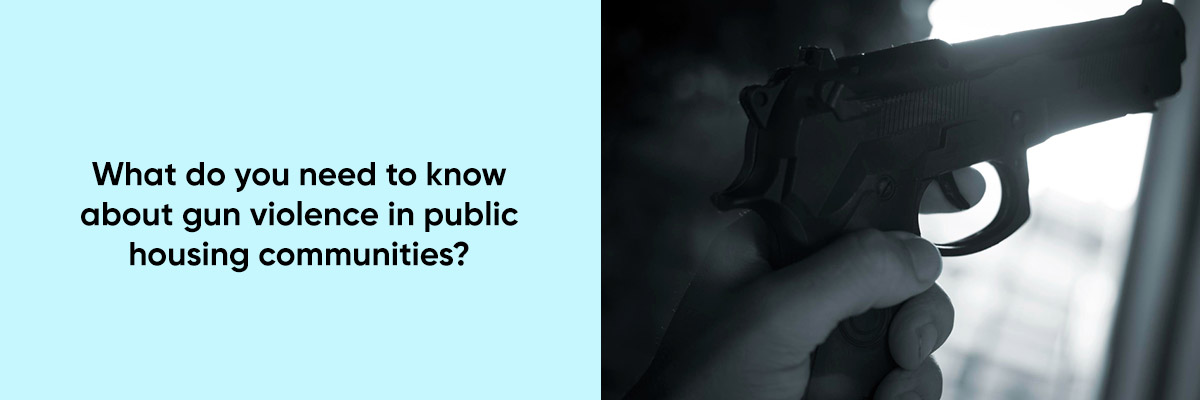The issue of gun violence has far-reaching consequences across the United States, affecting countless communities. Public housing communities are also affected by these tragedies, where residents are faced with unique challenges.
It poses a serious problem for landlords and property managers, making them consider if they should ban guns at their rental properties. Also, they are intrigued by HUD’s recent regulations and reports.
So, in this blog, we delve into the findings of a groundbreaking report by the U.S. Department of Housing and Urban Development (HUD), shedding light on the intricate web of factors contributing to gun violence in public housing and the associated costs, both financial and social.



The Scope of Public Housing:
There are more than 1,12 million public housing units in 14,000 developments managed by 3,200 public housing authorities across the country. As part of the United States Housing Act of 1937, this system aims to provide affordable housing for low-income families. Public housing communities, however, face the challenge of maintaining livability and security amidst persistent gun violence.
Gun Violence In Public Housing: HUD’s Key Findings:
- Declining Overall Crime Rates:
Despite the challenges, crime rates have been dropping in public housing communities. For two-thirds of 55 public housing authorities, crime rates declined between 1994 and 1997, according to detailed crime-trend data. Many housing authorities witnessed crime rates decreasing even more than the cities in which they are located.
- Lingering Issue of Gun-Related Crime:
Although overall crime rates have gone down, gun-related crimes remain a big problem. Residents are twice as likely to be victims of firearm-related crimes as the general population. This threatens the 2.6 million people who live in public housing, including over a million kids and 360,000 seniors.
- Universal Threat to Residents:
The rate of gun violence isn’t just confined to the biggest cities; smaller and medium-sized cities are also at risk. Public housing residents in smaller metro areas experience similar or higher rates of gun violence victimization than those in larger metro areas, emphasizing how widespread this problem is.
- Broader Impact Beyond Crime:
There’s more to gun violence than crime statistics. It causes unintentional injuries, deaths, and suicides. Since 1990, public housing authorities have spent over $4 billion on crime reduction and prevention.
- Psychological Impact on Residents:
There’s more to gun violence than physical harm: it creates a sense of insecurity, with one in five people feeling unsafe in public housing. Post-traumatic stress disorder may affect children exposed to such violence, just like it does after wars or big catastrophes.
HUD’s Response and Future Initiatives To Curb Gun Violence:
In response to the urgent need for improved safety measures, HUD’s FY2001 Budget includes a $35 million boost for the Public Housing Drug Elimination Program. Through improved analysis, community engagement, and innovative prevention efforts, this funding helps local communities reduce crime and prevent gun violence.
U.S. Gun Violence: Factors Contributing & Solutions
According to a report published by the Office of Juvenile Justice and Delinquency Prevention, there are more than 3,875 youth gangs in the 79 largest U.S. cities with more than 200,000 members. There are a lot of things that make youth gang members: poverty, school failure, drug abuse, family dysfunction, and domestic and societal violence. For kids with low education and limited employment opportunities, illicit drugs and the perceived financial rewards of drug dealing are attractive alternatives, causing them to engage in high-risk behaviors. People who join gangs often have low self-esteem, poor self-image, and little adult involvement.
Let’s discuss some more reasons behind the growing gun violence in the U.S. that is putting so many people’s physical and mental health at risk:
- Socioeconomic Factors:
There’s a lot of poverty in public housing communities, and there aren’t many economic opportunities. Inequality can lead to frustration, desperation, and criminal activity, including gun violence. It’s important to deal with the root causes of poverty and implement social programs.
- Limited Educational Opportunities:
Often, public housing communities lack educational resources, leading to poverty and crime. Having no access to quality education can lead to higher dropout rates and fewer job opportunities, increasing the likelihood that people will turn to illicit activities, like gun crimes. Breaking this cycle can be done by investing in education and after-school programs.
- Gang Activity:
The presence of gangs contributes a lot to gun violence in public housing. Many people, especially youth, join gangs for protection or belonging. These gangs usually fight territorial disputes, traffic drugs, and do other criminal stuff with firearms. The solution to gang-related gun violence is community-based intervention programs and targeted law enforcement.
- Easy Access to Firearms:
The accessibility of firearms plays a pivotal role in the prevalence of gun violence. Public housing communities often experience higher rates of illegal firearm possession due to lax gun control measures, loopholes in existing regulations, and black-market activities. Strengthening gun control laws and implementing effective background checks are essential steps to reduce the flow of illegal firearms. In America, gun violence is increasing and state laws can lead to more deaths, according to reports.
- Community Policing and Trust:
Gun violence can be prevented by building trust between law enforcement and public housing communities. By engaging with residents to address concerns and build positive relationships, community policing can help close the gap. The establishment of trust ensures that residents feel comfortable reporting criminal activity, thus fostering a safer environment.
- Mental Health and Substance Abuse:
Gun violence is often caused by mental health and substance abuse issues. These problems are exacerbated by a lack of mental health resources and treatment. Investing in mental health services and substance abuse prevention programs can help deal with underlying issues.
- Collaborative Community Efforts:
A collaborative effort is needed to solve gun violence in public housing. In order to implement effective solutions, local government, law enforcement, community leaders, and residents have to work together. Residents can take an active role in creating safer neighborhoods through community engagement, outreach programs, and grassroots initiatives.
Conclusion:
While strides have been made in reducing crime in public housing communities, the specter of gun violence persists. This report serves as a stepping stone for improved crime-analysis techniques and lays the foundation for sophisticated evaluation efforts. By understanding the specific challenges faced by the 2.6 million residents of public housing, targeted responses can be developed to ensure their safety and well-being. The ongoing commitment of HUD and collaborative efforts from local communities are essential to overcoming the multifaceted issue of gun violence in public housing.


